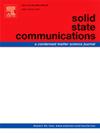高效率过氧化物-CIGS-SnS 三结串联太阳能电池的光谱管理和电流匹配优化
IF 2.1
4区 物理与天体物理
Q3 PHYSICS, CONDENSED MATTER
引用次数: 0
摘要
本研究使用低成本材料制造三结串联太阳能电池(TSC)。利用 SCAPS-1D 模拟器,采用两步滤波光谱和电流匹配技术设计了一种基于包晶-CIGS-SnS 的 TSC。为设计 TSC,顶部电池 (TC) 采用 1.5AM 光谱照明,中间电池 (MC) 则采用 TC 的未吸收光谱。同样,MC 的未吸收光谱用于照亮底部电池 (BC)。这项工作的其他优点:所使用的过氧化物是二维 Dion Jacobson (DJ) 过氧化物,比传统过氧化物更稳定。结果表明,TC/MC/BC 的有源层厚度(纳米)分别为 365/600/100 时,可实现电流匹配。所提出的太阳能电池具有显著的光伏性能:3.25 V VOC、9.42 mA/cm2 JSC、79.3 % FF 和 24.27 % PCE。本文章由计算机程序翻译,如有差异,请以英文原文为准。
Spectral management and current matching optimization for high-efficiency perovskite-CIGS-SnS triple junction tandem solar cells
Low-cost materials are used in this work to make a triple-junction tandem solar cell (TSC). Two-step filtered spectrum and current matching techniques are used to design a perovskite-CIGS-SnS based TSC using a SCAPS-1D simulator. To design a TSC, the top cell (TC) is illuminated with a 1.5AM spectrum, and the unabsorbed spectrum of the TC is utilized for the middle cell (MC). Similarly, the unabsorbed spectrum of the MC is used to illuminate the bottom cell (BC). Additional merits of this work: the perovskite used is a two-dimensional Dion Jacobson (DJ) perovskite, which is more stable than conventional perovskites. The results show that current matching is obtained at active layer thickness (nm) of 365/600/100 for TC/MC/BC, respectively. The proposed solar cell shows a remarkable PV performance of 3.25 V VOC, 9.42 mA/cm2 JSC, 79.3 % FF and 24.27 % PCE.
求助全文
通过发布文献求助,成功后即可免费获取论文全文。
去求助
来源期刊

Solid State Communications
物理-物理:凝聚态物理
CiteScore
3.40
自引率
4.80%
发文量
287
审稿时长
51 days
期刊介绍:
Solid State Communications is an international medium for the publication of short communications and original research articles on significant developments in condensed matter science, giving scientists immediate access to important, recently completed work. The journal publishes original experimental and theoretical research on the physical and chemical properties of solids and other condensed systems and also on their preparation. The submission of manuscripts reporting research on the basic physics of materials science and devices, as well as of state-of-the-art microstructures and nanostructures, is encouraged.
A coherent quantitative treatment emphasizing new physics is expected rather than a simple accumulation of experimental data. Consistent with these aims, the short communications should be kept concise and short, usually not longer than six printed pages. The number of figures and tables should also be kept to a minimum. Solid State Communications now also welcomes original research articles without length restrictions.
The Fast-Track section of Solid State Communications is the venue for very rapid publication of short communications on significant developments in condensed matter science. The goal is to offer the broad condensed matter community quick and immediate access to publish recently completed papers in research areas that are rapidly evolving and in which there are developments with great potential impact.
 求助内容:
求助内容: 应助结果提醒方式:
应助结果提醒方式:


